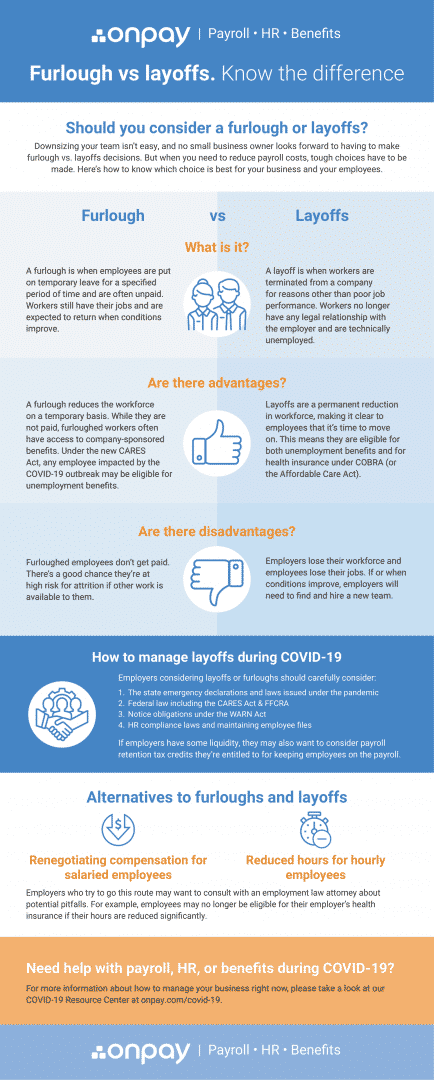Furloughs vs. Layoffs – What’s the Difference?

We’re hearing a lot of stories about furloughs and layoffs lately, but what’s the difference? And which one makes sense for your business if you have to reduce the size of your workforce?
While both terms are generally used to describe a situation in which employees stop receiving a paycheck, there are some key differences between the two. If you’re wondering which is the best solution for your business, here’s a detailed look at how to think about it — and about specific issues that arise from COVID-19:
Want to learn more about furloughs vs. layoffs? Read on for additional detail:
Furloughs
A furlough is when employers decide to put employees on temporary leave with the expectation that they are to return when work conditions improve. Putting employees on furlough allows businesses to decrease monthly payroll costs and catch up on any past-due expenses, without permanently reducing the size of the company.
While time on furlough is generally unpaid, employees usually still have access to company-sponsored benefits like health insurance, so they remain covered throughout their time on leave. And, they still have the reassurance that they will be returning to work when circumstances change.
Handling furloughs can look a little different for exempt vs. non-exempt employees. The Fair Labors and Standards Act (FLSA) outlines the way furloughs should be handled for both. For non-exempt employees, who are usually paid on an hourly basis, employers have more flexibility.
They can reduce working hours by day, week, or month. But, exempt employees, who are usually paid a salary, must be paid in full for the entire week, even if they only worked one day, according to the FLSA. Thus, exempt employees are generally furloughed for a specified number of weeks or months.
Layoffs
A layoff is a permanent termination of an employee for a reason unrelated to job performance, and more often than not related to insufficient funds to continue paying that employee regularly.
When an employee is laid off, they no longer have any ties to the company, meaning they are eligible for unemployment benefits as well as health insurance under the Affordable Care Act or COBRA, unlike furloughed employees.
A layoff is a decision to be made when you’re 100% sure your business can no longer support this employee. If you suspect that the problem you’re having will be solved at some point in the near future, a furlough may be a better option.
If you’re looking to save some money for your business, but not ready to take the plunge and start laying off or putting employees on furlough, you can start out by simply reducing work hours or cutting their pay (within reason). If you have done both and find your business is still struggling, it may be time to consider taking it a step further.
We hope this clarifies the difference and helps you make a more informed decision for your business and your employees.
This infographic was provided by online payroll and HR provider OnPay, who earns top ratings for making employee management easy, affordable, and error-free for small businesses and their accountants.

